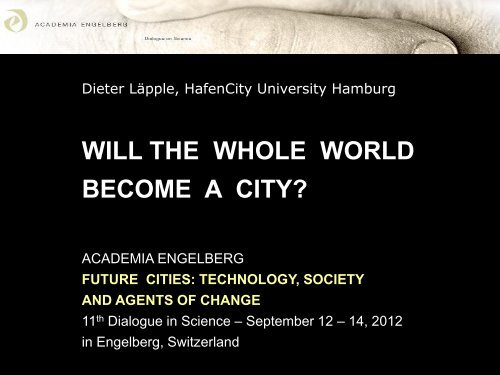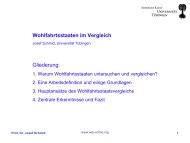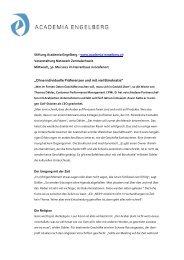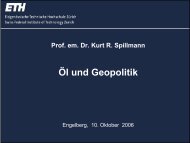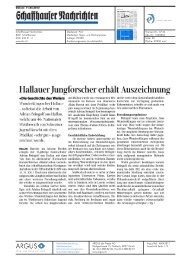Presentation of Professor Dieter Läpple - ACADEMIA ENGELBERG
Presentation of Professor Dieter Läpple - ACADEMIA ENGELBERG
Presentation of Professor Dieter Läpple - ACADEMIA ENGELBERG
You also want an ePaper? Increase the reach of your titles
YUMPU automatically turns print PDFs into web optimized ePapers that Google loves.
<strong>Dieter</strong> <strong>Läpple</strong>, HafenCity University Hamburg<br />
WILL THE WHOLE WORLD<br />
BECOME A CITY?<br />
<strong>ACADEMIA</strong> <strong>ENGELBERG</strong><br />
FUTURE CITIES: TECHNOLOGY, SOCIETY<br />
AND AGENTS OF CHANGE<br />
11 th Dialogue in Science – September 12 – 14, 2012<br />
in Engelberg, Switzerland
Lewis Mumford:<br />
“This book opens with<br />
a city that was, symbolically,<br />
a world;<br />
it closes with<br />
a world that has become,<br />
in many practical aspects,<br />
a city.”<br />
(1961, XI)
Assyrian picture <strong>of</strong> the destruction <strong>of</strong> a city<br />
Cites are probably<br />
humankind’s most complex<br />
creation, never finished,<br />
constantly changing.<br />
They are manifestations<br />
<strong>of</strong> history and culture;<br />
incubators <strong>of</strong> innovation<br />
and creativity;<br />
arenas <strong>of</strong> political, cultural and<br />
social struggles.<br />
They are build, sometimes<br />
destroyed, rebuild, transformed,<br />
occupied by different groups,<br />
and used for different functions.
Peter Bruegel: Tower <strong>of</strong> Babel; 1563<br />
Quelle: www.abcgallery.com<br />
Cities are not just<br />
brick and mortal,<br />
glass, concrete, steel and tarmac.<br />
From their beginning they symbolize<br />
the dreams <strong>of</strong> societies.<br />
They are spaces <strong>of</strong> hope and<br />
spaces <strong>of</strong> opportunities;<br />
And cities are open systems;<br />
open for foreigners, new ideas,<br />
new aesthetic forms and new<br />
developments.<br />
And cities incorporate diversity<br />
and heterogeneity.
The 21 st century – the Century <strong>of</strong> the City<br />
We are facing the transition to a predominantly urban world:<br />
“What will be remembered about the twenty-first century,<br />
more than anything else except perhaps the effects <strong>of</strong><br />
changing climate, is the great, and final, shift <strong>of</strong> human<br />
populations out <strong>of</strong> the rural, agricultural life and into cities.<br />
We will end this century as a wholly urban species.”<br />
(Doug Saunders: Arrival City, 2011)
Percentage <strong>of</strong> urban population and agglomerations by size class, 1960<br />
Source: United Nations, Department <strong>of</strong> Economic and Social Affairs, Population Division:<br />
World Urbanization Prospects, the 2011 Revision. New York 2012
Percentage <strong>of</strong> urban population and agglomerations by size class, 2011<br />
Source: United Nations, Department <strong>of</strong> Economic and Social Affairs, Population Division:<br />
World Urbanization Prospects, the 2011 Revision. New York 2012
Percentage <strong>of</strong> urban population and agglomerations by size class, 2025<br />
Source: United Nations, Department <strong>of</strong> Economic and Social Affairs, Population Division:<br />
World Urbanization Prospects, the 2011 Revision. New York 2012
The 21 st century: Century <strong>of</strong> the City<br />
The centre <strong>of</strong> gravity <strong>of</strong> the urban landscape is moving South and East.<br />
It is estimated that more than 90 percent <strong>of</strong> the future urban population<br />
growth will occur in the cities <strong>of</strong> Asia and Africa.<br />
Asia and Africa have already three-quarters <strong>of</strong> the world’s 100 fastest-<br />
growing large cities.<br />
With a growth <strong>of</strong> the urban population <strong>of</strong> the developing world <strong>of</strong><br />
three million people per week – it seems likely:<br />
the urban future does not lie in Europe or North American cities.
Century <strong>of</strong> the ‘City’<br />
Some conceptual problems and problems <strong>of</strong> definition:<br />
� Confusion between urbanization and urban growth:<br />
- Urbanization: the increasing proportion <strong>of</strong> a population living<br />
in settlements defined as urban centers (rural-urban migration);<br />
-“Urban growth” means the growth <strong>of</strong> the population in urban centers<br />
in absolute terms but not in the increase in levels <strong>of</strong> urbanization.<br />
� “Urban centers” or “Cities”?<br />
All data are coming from the UN Population Division based on the<br />
census <strong>of</strong> national governments with different definitions for urban<br />
centers (between 2.500 or more inhabitants or all settlements with<br />
15.000 or more inhabitants).<br />
Each nation uses its own criteria for defining urban center not cities.
Some popular myths concerning urban change:<br />
It is a common misconception to believe that MEGACITIES are<br />
growing very fast. Contrary to general belief, the bulk <strong>of</strong> urban<br />
population growth is likely to be in second-tier cities and smaller towns.<br />
Also the economic performance <strong>of</strong> the megacities is <strong>of</strong>ten<br />
overestimated. In fact, many <strong>of</strong> these huge metropolises are already<br />
growing more slowly than the economy <strong>of</strong> their host countries.<br />
Today’s megacities account for 4 percent <strong>of</strong> the world’s population and<br />
9 percent <strong>of</strong> all urban inhabitants. This is an important share, but it will<br />
probably not expand quickly in the foreseeable future.<br />
Economic success need not imply ever-lager cities, as some European<br />
cities show. (� obsession about hierarchies concerning the size <strong>of</strong><br />
cities)
Rural-urban migration and natural growth:<br />
In spite <strong>of</strong> the importance <strong>of</strong> the rural-urban migration most urban<br />
growth today stems from natural increase <strong>of</strong> the urban population.<br />
Many policymakers try to prevent urban growth by discouraging rural-<br />
urban migration, with tactics such as evicting squatters and denying<br />
them service.<br />
Advances in social development and making education universally<br />
available will, amongst others, enable women to avoid unwanted<br />
fertility and reduce the main factor in the growth <strong>of</strong> urban population –<br />
natural increase.
The „urbanization <strong>of</strong> poverty“ and the expansions <strong>of</strong> slums<br />
Mike Davis<br />
Until recently, rural settlements<br />
were the epicenter <strong>of</strong> poverty.<br />
As the developing world becomes<br />
more urban, the “locus <strong>of</strong> poverty”<br />
shifts to cities. Many developing<br />
countries generate not enough jobs<br />
to meet the demands <strong>of</strong> the growing<br />
population.<br />
Many <strong>of</strong> the new poor urbanites will<br />
live in informal settlements or in<br />
slums and will suffer from<br />
overcrowding and environmental<br />
degradation.
In 2001, 924 million people, or 31,6<br />
per cent <strong>of</strong> the world’s population,<br />
lived in slums.<br />
UN Habitat projected that in the next<br />
30 years, the global number <strong>of</strong> slum<br />
dwellers will increase to about 2<br />
billion, if no firm and concrete action is<br />
taken.<br />
Over the last 10 years, the proportion<br />
<strong>of</strong> urban population living in slums has<br />
declined, but in absolute terms the<br />
number have actually grown<br />
considerably , and will continue to rise.
Slums <strong>of</strong> hope – slums <strong>of</strong> despair<br />
Slums as poverty trap or transitional spaces<br />
Saunders labeled the transitional spaces: “arrival cities”<br />
For Saunders “arrival cities” can function as “key instrument<br />
in creating a new middle class, abolishing the horrors <strong>of</strong> rural poverty<br />
and ending inequality”<br />
“These transitional spaces – arrival cities – are the places<br />
where the next great economic and cultural boom will be born,<br />
or where the next great explosion <strong>of</strong> violence will occur.<br />
The difference depends on our ability to notice, and our<br />
willingness to engage.” (Saunders: Arrival City)<br />
The challenge is in learning how to exploit the possibilities <strong>of</strong><br />
Urbanization.
Urban food security – a pressing challenge;<br />
The need for new urban-rural linkages<br />
• With the “urbanization <strong>of</strong> poverty” and rising<br />
unemployment food security has become a major<br />
concern in most cities <strong>of</strong> the developing world.<br />
• Urban agriculture is increasingly practiced by the poor to<br />
supplement declining income and to mitigate food and<br />
income insecurities<br />
• The shaping <strong>of</strong> rural-urban linkages have to be placed<br />
high on the agenda and we have to reformulate our<br />
concept <strong>of</strong> cities.
Rural and urban poverty<br />
Urban poverty rates are, overall, lower than those in rural areas;<br />
the migration <strong>of</strong> population from rural to urban areas actually<br />
helps to reduce national poverty rates.<br />
Poverty has been reduces and inequality has declined<br />
with urbanization in those countries that allow their<br />
“arrival cities” to flourish.<br />
Many <strong>of</strong> the urban poor are not rural-urban migrants,<br />
but poor people displaced from other parts <strong>of</strong> the city.
The city as place to survive: Informal settlements / informal economy
NEST _ NEW ETHIOPEAN SUSTAINABLE TOWN<br />
model town in the Lake Tana Region
The urban divide: Favela Paraisópolis / gated community <strong>of</strong> Morumbi
Urbanity vs gated community
The rise or a new<br />
middle class<br />
(with an annual income<br />
above<br />
$ 20.000 per<br />
household)<br />
in the developing<br />
world will result<br />
in a considerable<br />
purchasing power<br />
and the demand<br />
for a ‘modern’ way<br />
live.
The legacy <strong>of</strong> the<br />
fossil urbanism<br />
The outdated modernity<br />
Several additional Earths<br />
would be required<br />
to allow all <strong>of</strong> humanity<br />
to live in suburban houses<br />
with two cars and lawn.<br />
27
The dominant urbanization<br />
patterns expanding<br />
all over the world<br />
are still highly<br />
fossil-fuel dependent<br />
with high impact<br />
on global warming<br />
and climate change.<br />
The effects <strong>of</strong> urbanization<br />
and climate change are<br />
converging and threaten the<br />
world’s environmental,<br />
economic and social stability.
Cities account for<br />
half <strong>of</strong> the world’s population<br />
and generate around<br />
80% <strong>of</strong> global GDP<br />
on 3% <strong>of</strong> the Earth’s land area<br />
Global and local transport: 95% oil dependent<br />
but:<br />
- they consume 75% <strong>of</strong> energy,<br />
- they generate 80% <strong>of</strong> waste,<br />
- they are directly responsible<br />
for 60% <strong>of</strong> GHG emissions.<br />
However, the problem is not:<br />
urban concentration<br />
but unsustainable patterns <strong>of</strong><br />
production and consumption
Important differences in causes and impacts<br />
• In cities <strong>of</strong> poor countries, most environmental problems are local<br />
and mostly concern health, such as inadequate water and<br />
sanitation, poor air quality and lacking waste disposal.<br />
• In more affluent cities, local and regional impacts have usually<br />
declined through environmental regulations, investment in waste<br />
treatment and pollution control, and the outsourcing <strong>of</strong><br />
manufacturing. But these affluent cities have a strong impact on<br />
global warming and climate change.<br />
• Climate change will make particular the poorest and most<br />
marginalized increasing vulnerable to floods, landslides,<br />
extreme weather events and other natural disasters.
Critique <strong>of</strong> the ‘modern’ city<br />
In the tradition <strong>of</strong> the Western discourse the ‘modern’ city is<br />
conceived as an effective engine <strong>of</strong>fering the emancipation<br />
from the constraints <strong>of</strong> nature.<br />
The ‘modern city’ frees the urbanites from cultivating their food,<br />
helps them to overcome the constraints <strong>of</strong> space and time,<br />
<strong>of</strong> day and night, <strong>of</strong>fers affluent energy and water without concern<br />
about waste and emission.<br />
In this vision <strong>of</strong> modernity the city frees the urbanites from physical<br />
work and accountability. By this, cities became veritable “entropy<br />
engines” with an ever expanding ecological footprint.<br />
This urban way <strong>of</strong> live is not only damaging the ecosystem, but also<br />
questioning the survival <strong>of</strong> humanity.
The vision <strong>of</strong> the future city<br />
100 years ago:<br />
A big engine for the annihilation<br />
<strong>of</strong> space<br />
Metropolis (Otto Hünte 1929)
The Rediscovery <strong>of</strong> the City as living space
Towards a reshaping and pluralization <strong>of</strong> modernity<br />
Our ways <strong>of</strong> modernization, our production regimes and modes <strong>of</strong><br />
consumption have eroded the resilience not only in many natural<br />
systems, but also in many social and economic systems.<br />
Europe invented modernity. Therefore we have a special responsibility<br />
to contribute to a reshaping <strong>of</strong> modernity at a global level to find ways<br />
to reconcile our production regimes , our modes <strong>of</strong> consumption, and<br />
Our forms <strong>of</strong> civilization with nature.<br />
The challenge is in learning how to use the creativity <strong>of</strong> people,<br />
new technologies and the possibilities <strong>of</strong> urbanization for this big task.
Will the whole world become a city?<br />
There is a high plausibility that in this century the whole world will<br />
become a city.<br />
There will rise new urban configurations in which the rural<br />
will be integrated. (“urban archipelagos”)<br />
The future cities will have many faces and a high diversity <strong>of</strong> forms.<br />
There is no longer “the” future city as a manifestation <strong>of</strong> the most<br />
advanced technology and ‘urban modernity’, which will serve as<br />
model to follow.<br />
In the coming transition processes it will be crucial to open up<br />
new opportunities for imagining the distinctive futures <strong>of</strong> all cities<br />
and towns and to use the creativity <strong>of</strong> their inhabitants to develop<br />
an equitable, sustainable and resilient urban future.
Thank you for your attention


